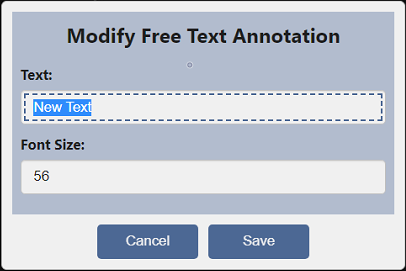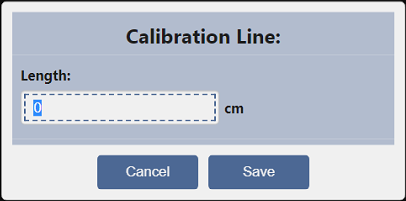Annotations
Press the Annotations button to enter Annotation mode. The Annotations tool bar will slide up over the Image Manipulation tool bar. In this mode you can add and remove annotations, and modify existing ones. When you are finished, press the check mark to stop annotating and the Annotation toolbar will slide back down out of view.
Erase Annotations
Press the Erase Annotations button to remove all annotations from an image.
Free Text
Press the Free Text Annotation button to add a new Text Annotation to the image.
To edit the content of the Free Text Annotation, right click the annotation with the mouse or long press the annotation with the touch screen. The Modify Free Text Annotation form will open.

Press the Save button to save the changes and close the form. Press the Cancel button to discard any changes and close the form.
You can move the annotation by dragging it.
To remove the annotation, simply move it off of the image.
Left And Right Markers
Press the icon for the desired marker, this will add it to the image. You can then drag the marker to position it on the image.
Only one marker is allowed per image.
You can change the color of your annotations in the Intermediate Options menu.
Arrow
To place an arrow annotation, press the Arrow Button. This will place an arrow in the center of the image. To move the arrow, drag it from the center of the line. To move just one end of the arrow, drag from the end you wish to move.
Measurement
To draw a measurement line, press the Measurement button. This will place a measurement line in the center of the image. To move just one end of the line, drag from the end you wish to move. You can move the end points by dragging them. You can move the entire annotation by dragging from the middle of the line. You can reposition the measurement text by dragging the text.
The default unit of measurement is cm but you can change it in the Settings Screen under Basic Options.
Calibration
By default the image is calibrated using the pixel pitch of the Detector. However, to get the most accurate measurements, you will need to place an object of known length in the image and use the Calibration annotation to calibrate the image. To do this, press the Calibration button. This will place a calibration line in the center of the image.
Place the calibration line over item you are using for calibration, with the points place on the edges of the object. The calibration will start out being measured in pixels, so when you are satisfied with the placement of the Calibration line, long press or right click on the annotation to open the Edit Calibration Form will show.

Enter the length of the calibration object and press the Save button and the form will close. Pressing the Cancel button will dismiss the form and not save the edits.
You can move the entire calibration annotation by dragging from the center of the line. You can move the text by dragging the text.
Only one calibration line is allowed per image.
Angle
To measure an angle, press the Angle button. This will place an angle measurement in the center of the image. You can move each of the points by dragging them. You can move the entire annotation by dragging from one of the lines. You can move the Angle Measurement text by dragging it.
Cobb Angle
To perform a Cobb angle measurement, press the Cobb Angle button. This will place the Cobb angle measurement in the center of the image. You can move each of the points by dragging them. You can move each of the lines independently by dragging from the middle of them. You can move the Angle Measurement text by dragging it. The angle formed by these lines is the Cobb angle.
The Cobb angle was first described in 1948 by American orthopedic surgeon John R Cobb (1903-1967).
Create a copy
This will create a copy of the current image and its annotations and add it below the shot in the shot list, then remove the annotations from the original image.
The copy tool can only be used to copy an image with annotations. If the tool is inactive, check to make sure you have some annotations applied to your current image.